Paul Manley Back Pain and RSI Clinic
Paul Manley, M.A.O.(Manip), Registered Osteomyologist
RSM (Royal Society of Medicine)
Specialist in the treatment of Musculo-skeletal problems
Location: 8-10 Boston Place, Marylebone, London NW1 6QH
Next to Marylebone Station, Main line trains and Bakerloo line
19/01/2026
Common wrist joint and thumb problems.
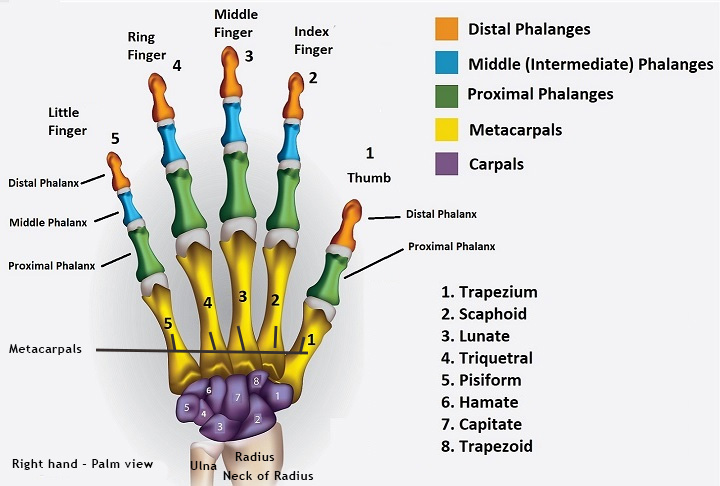
One of the most common long term wrist problems can occur as the result of a fracture of the Radius bone at the Neck of the Radius.
The joint between the Scaphoid and the Radius can become adhered and the joint becomes mis-aligned. This causes pain, aching and loss of mobility in the wrist. The tendons running over and under the joint become irritated and their associated muscles become hypertonic or weak. The chances of getting carpal tunnel symptoms increase greatly.
This problem is easily resolved by manipulation of the joint(s) involved and by using myo-articulation for the tendons and muscles.
Minor tears of the cartilages between the carpal joints can also occur. These limit movement and can be very painful. They can be re-aligned using very specific techniques and can heal.
Even minor injuries of the finger joints produce swelling of the joints. Repetitive strain will also cause swelling. They will frequently result in outgrowth of the joint which can be classed as osteo-arthritic.
At first the injury causes inflammation and swelling. The synovial fluid thickens and becomes more 'sticky'. The bone begins to enlarge and crystals of calcium are deposited in the periphery of the joint. These are painful when you try to use the joint and will when combined with the shortening of the ligaments greatly limit the range of movement. The longer the crystals persist, the greater the erosion of the joint surfaces.
This pathological process can be reversed by mobilising the joints. When a vacuum force is applied to the joints the synovial fluid is 'sucked' back in to the joints and mobility is restored and ligaments become healthier. So to stretch and pull the joints is a good thing. Specialised techniques as performed by someone who knows how are often miraculous in restoring full function.
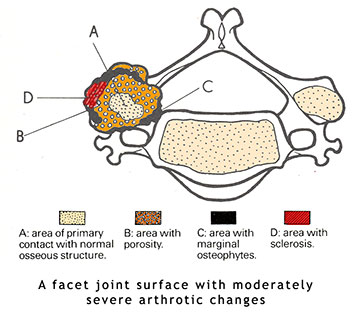
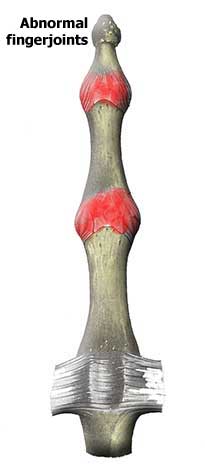
A Testimonial from a drummer
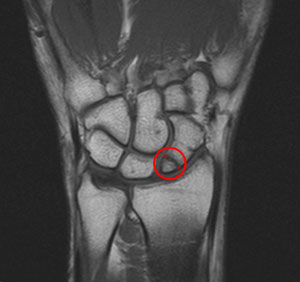
On my first session with Paul, he listened closely to my description of the pain and tried to establish why it may have come about. He began work and was able to get to the root of the problem immediately.
After a single, very thorough session I had fantastic results and knew I had found the right man to help me get through this injury. The tension in my arm was massively reduced and the shooting pains all but gone. I was able to resume my practising and performing schedule straight away which was a huge relief. After 3 sessions with Paul my arm felt as good as new! Paul was also able to offer invaluable advice on how to avoid similar problems arising again.
I was extremely impressed with Paul's personal and sympathetic approach and delighted with the wonders he worked on the tension in my arm which I thought was going to keep me out of work for a LONG time. I would recommend him to anybody I know with any similar injuries".
Case 1:
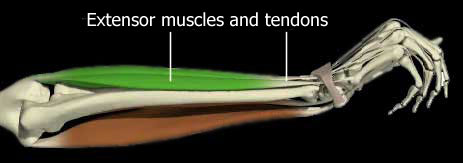
Findings:
Of athletic build his general muscle tone was higher than I would normally see in a musicians body. This extended to the muscles which were responsible for his symptoms. The deep extensors were very tense and starving themselves of Oxygen because of the restriction to blood flow due to the extreme increased tone in the muscles.
Following one treatment and a couple of follow-up sessions, he made a complete recovery and went on to gain an Honours degree and succesfully competed in many high level music competitions.
Case 2:
An awkward fall on to the left hand had resulted in an injury which had prevented performance for a year in this fiddle player. The problem was very specific and involved great pain when trying to play high notes with the little finger, trills and prolonged sustains being the main aggravators.
Pain and inflammation resulted on the back of the hand around the area of the Hamate/Capitate/metacarpal joints.
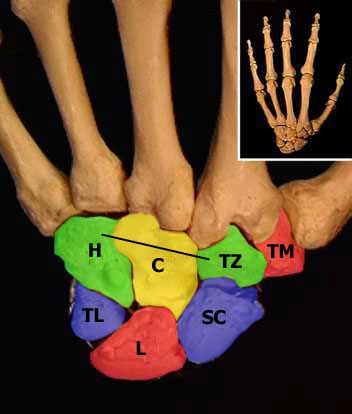
Findings:
The Capitate had turned on its horizontal axis and the upper portion was now 'sticking up', thereby irritating the ligaments binding it as well as the extensor tendon of the little finger which passes over it. See the diagram below: the black line is the horizontal axis of the Capitate. The red area ( illustrated left ) was the centre of irritation.
Following two months of treatment the condition subsided and she is now able to function fully.
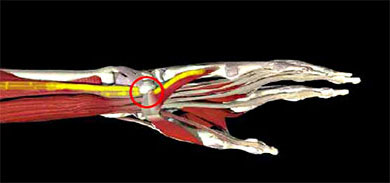
Case
3:
Following a fall on to the right hand some months previously, this young cellist experienced great pain in the area of the lateral side of the wrist. (Spread of pain in yellow in figure on the right). She was incapable of 'bowing' for anything other than short periods.
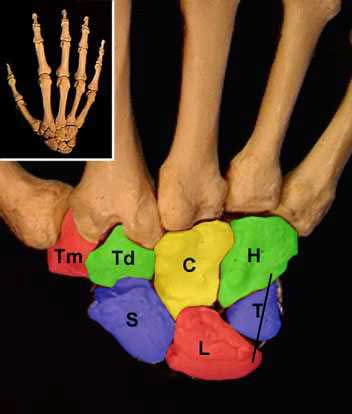
Findings:
The
Triquetral bone was displaced, having rotated on its vertical axis
( see left diagram ). Its lateral edge was prominent and although
there was some mobility between it and its neighbours, it remained
in a relatively depressed position. This gave rise to mild inflammation
in the joint and the tendons which pass over it on the palmar side.
The result for 'bowing' was profound difficulty.
Following three treatments, full function was restored and remains to this day.
Case 4:
A
tear of the attachment of the extensor tendon to the tip of the
left little finger had resulted in complete loss of function and
inflammation of the joint.
A guitar player, he could no longer use the digit.
extensor tendon to the tip of the
left little finger had resulted in complete loss of function and
inflammation of the joint.
A guitar player, he could no longer use the digit.
Findings:
Three months after the injury, some exostosis or 'outgrowth' of bone had occured resulting in some moderate deformity of the joint. Strength was very weak and the tendency to re-injure was very high.
Following several treatments over a three month period strength and mobility had returned. After specific finger exercises the patient now has more strength than ever before and the problem no longer exists.
Case 5:
A fall on to the left hand 2 years previously had left this fiddle player unable to play or write ( she was left-handed ) and with a continual ache in the wrist joint and up the flexor and extensor tendons with transient pins and needles in the fingertips. She was in extreme distress and had given up on her career, once a renowned performer.
The Scaphoid and lunate joints with the Radius and Ulna were impacted and their ranges of movement reduced by 95 %. The long flexor tendons of the thumb were inflammed at the region of the wrist joint. The deep flexor and extensor tendons were on high tension and their associated muscle portion was overtoned and very dense.
Following four sessions, movement was regained, the areas were much more comfortable and playing rehab commenced. Three months later she was playing again. Within six months she was able to return to the rigours of a full shedule.
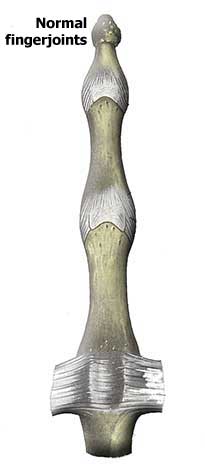 Case
6:
Case
6:
A busy professional pianist, in his late 20's had stiff fingerjoints which were becoming progressively more arthritic. Mobility and speed, deftness and rhythmic control were all affected badly.

Findings:
Most
of the finger joints were slightly swollen, some more than others.
The worst joints were prone to getting exczema over them. The patient
said that the excema usually preceded the joint aggravation.
50% of the joints had 'crystals' of calcium salts grinding roughly
within them. The joint shapes had retained their normal shapes.
Following six treatments over three months the fingers had progressively improved as had the exczema. Twenty years on and he is still playing at the top of his league.
This type of problem is very common. It especially affects people who use or over-use their thumbs in gripping and squeezing activities such as needlework, writing, playing musical instruments, gardening, playing darts (Dartitis) and many other similar activities. It affects females far more than males, especially during the menopause.
The thumb muscles can become 'rock-hard' over time. As a consequence the thumb joint at the base will suffer greatly. Functions of the thumb become progressively weaker and the joints become more easily inflammed and injured. Simple things like opening a jar or turning a door handle can be a painful problem.
With each prolonged period of inflammation, the more the joint will change shape by 'splaying' outwards. It will usually begin by leaving behind a bony nodule or bump, most often on the middle knuckle.
One must bear in mind that because ligaments attach to these, now distorted, surfaces, they will not be at an appropriate tension to do their job properly.
Trauma to the joint most often occurs when the joint is bent backwards suddenly. Often a fall onto the hand in an awkward position will sprain the joint. Sometimes skiers will get their ski pole stuck or it will twist in their grip, the thumb being restrained within the strap of the pole, the thumb is violently bent backwards. A knock to the base of the thumb or to the middle part of the palm surface of the thumb will produce a bruising which is often not visible but which can be very painful and take quite a long time to heal. Car accidents where the thumb is gripping the steering wheel and takes the full force of impact will be badly injured, sometimes causing a chip of bone to come loose. This is called an avulsion fracture. Most often I deal with the muscular and ligamentous/joint related causes of this syndrome, although I can help greatly with recovery in traumatic cases.
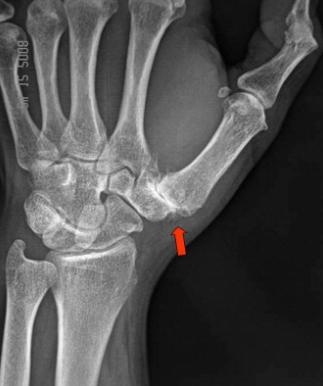
Figure 1.
Arthritis of the Carpo-metacarpal joint of the thumb.
There are a few ways to combat the build up of what begins as simple muscle tension. If you have the strength then grip the thenar eminence in a 'pincer' hold. Explore the areas within your grip. Feel for tough, painful areas of muscle and then rhythmically squeeze them between your gripping hand. In the illustrations below I am squeezing with my right hand.
Figures 2 and 3.
Grip and squeeze rhythmically.
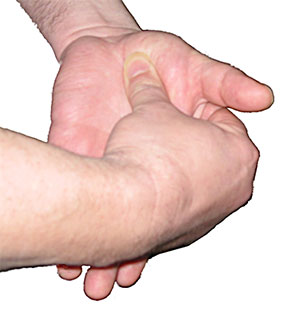
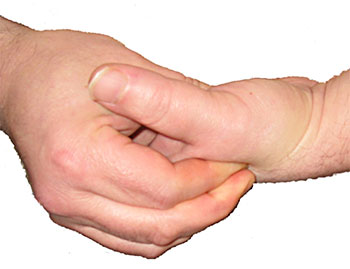
Note that the middle finger of my right hand is pressing onto my index finger to give additional pressure strength.
There are many other techniques which will be beneficial to this problem, but which are a little too complex to be shown here. Plus, I wouldn't want you to get them wrong and end up irritating the area.
If you can get to see me, give me a call and I will examine and treat these disabling syndromes. Even if the joint seems to have been affected and its appearance on X-ray is not too good, I can still help you a lot.
07925 616 753
Location: 8-10 Boston Place, Marylebone, London NW1 6QH
Next to Marylebone Station, Main line trains and Bakerloo line